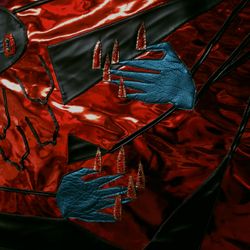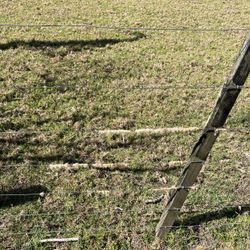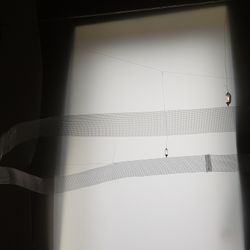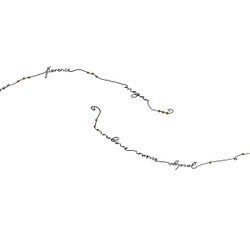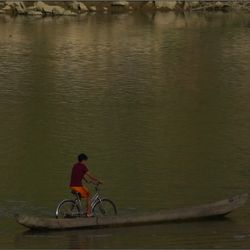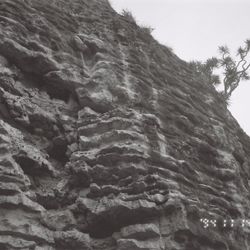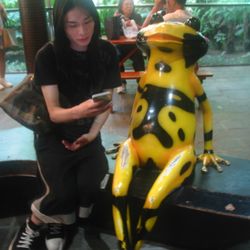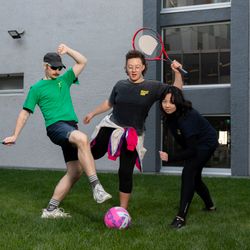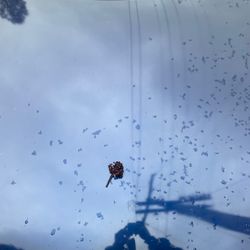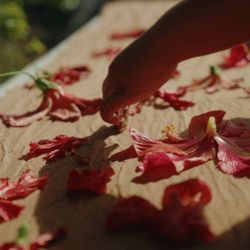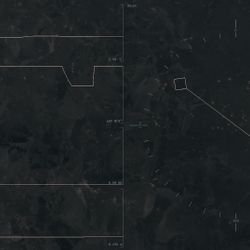′Uhila Nai’s exhibition Fepotalanoa′aki pea mo ′eku fanga kui: In conversation with my great-great-great-grannies presents a series of works which utilise the visual language of ancient Tonga and today’s lea Faka-Tonga to explore the tala tukufakaholo about the hou′eiki fafine (formal term for elder women) in her family and the continuations of their craft of nimamea′a koka′anga (ngatu making).
Past Exhibition
Hātarei 6 Ākuhata -
Hātarei 10 Hepetema
Saturday 6 August -
Saturday 10 September
2022
Image: Supplied by artist.
The title, Fepotalanoa′aki pea mo ′eku fanga kui: In conversation with my great-great-great-grannies, speaks metaphorically to the idea of kupesi as a way to connect with past generations of hou’eiki fafine in her family and also where she is from: the village of Pelehake. Nai draws on relationships between people and materials to share and continue the art of hou′eiki fafine through traditional materials used in the making, kafa (sennit) and contemporary materials, like vylene paper, which are adapted for the same purpose. The role of materials, such as hiapo (mulberry paper) and la′i kaka (fibrous integuments that wrap around a young coconut leaf) in transmitting knowledge is central to the writing of cultural histories and also to relations between people and materials, showing how makers have collectively embedded their knowledge through hours spent making.
The project explores the creative, conversational, and intergenerational space created by gathering together for koka′anga, the process of assembling all of the pieces of feta′aki (undyed barkcloth) together to create the final ngatu (tapa cloth). Koka′anga is a space where young kids get to see their grandmothers, mothers and aunties making ngatu, witness how one of their crafts is made, and come together to having a good laugh in the exchanges of conversation and knowledge.
These personal relationships, between older and younger generations are echoed in the relationships with fonua (the land), through the connection of hou′eiki fafine to land, given or passed from their ancestors. Nai responds to this embedding of fonua by creating mape (maps) drawn from, or close to, the year women in her family were born or the year they migrated to the main island of Tongatapu or to other islands.
By drawing on the concept of unfolding kupesi forms and learning about their individual characteristics, Nai has begun a process of mapping out and sharing the histories and memories carried within materials, processes, methods, and land.
View of Koka Time (taimi koka‘anga)
Papa koka’anga – 14 – 16 feet / kupesi –
variety of sizes – 19 x 20 inches &
19 x 60 inches, wood, kafa (sennit), fau
(hibiscus fibre), kavele‘ipulu (coconut hust)
kaka (coconut fibre), tu‘aniu
(coconut mid-rib)
View of Gallery One works
View of Gallery One works
View of Hakau ‘o e Lolotonga : reef of today is the
island of tomorrow, 850mm x 900mm,
Pepa koka‘anga (vylene paper), black ink,
brown charcoal.
View of Gallery One
View in Gallery Two of 'Uhila Nai, Ko homau fonua ne tala‘ofa mai ‘aki : Our Heartland ; Our Promise Land, 950mm x 1450mm, Pepa koka‘anga (vylene paper), black ink, black charcoal.
View in Gallery Two of 'Uhila Nai, Ko homau fonua ne tala‘ofa mai ‘aki : Our Heartland ; Our Promise Land, 950mm x 1450mm, Pepa koka‘anga (vylene paper), black ink, black charcoal.
View in Gallery Two of 'Uhila Nai, Ko homau fonua ne tala‘ofa mai ‘aki : Our Heartland ; Our Promise Land, 950mm x 1450mm, Pepa koka‘anga (vylene paper), black ink, black charcoal.
View in Gallery Two of Ko homau fonua ne tala‘ofa mai ‘aki :
Our Heartland ; Our Promise Land
950mm x 1450mm, Pepa koka‘anga
(vylene paper), black ink, black
charcoal.
Street view of Pass meet the Present (past meet
the present), 900mm x 3000m, Pepa
koka‘anga (vylene paper), black ink, brown
charcoal.
Side view of Pass meet the Present (past meet
the present), 900mm x 3000m, Pepa
koka‘anga (vylene paper), black ink, brown
charcoal.
View of Koka Time (taimi koka‘anga)
Papa koka’anga – 14 – 16 feet / kupesi –
variety of sizes – 19 x 20 inches &
19 x 60 inches, wood, kafa (sennit), fau
(hibiscus fibre), kavele‘ipulu (coconut hust)
kaka (coconut fibre), tu‘aniu
(coconut mid-rib)
View of Gallery One works
View of Gallery One works
View of Hakau ‘o e Lolotonga : reef of today is the
island of tomorrow, 850mm x 900mm,
Pepa koka‘anga (vylene paper), black ink,
brown charcoal.
View of Gallery One
View in Gallery Two of 'Uhila Nai, Ko homau fonua ne tala‘ofa mai ‘aki : Our Heartland ; Our Promise Land, 950mm x 1450mm, Pepa koka‘anga (vylene paper), black ink, black charcoal.
View in Gallery Two of 'Uhila Nai, Ko homau fonua ne tala‘ofa mai ‘aki : Our Heartland ; Our Promise Land, 950mm x 1450mm, Pepa koka‘anga (vylene paper), black ink, black charcoal.
View in Gallery Two of 'Uhila Nai, Ko homau fonua ne tala‘ofa mai ‘aki : Our Heartland ; Our Promise Land, 950mm x 1450mm, Pepa koka‘anga (vylene paper), black ink, black charcoal.
View in Gallery Two of Ko homau fonua ne tala‘ofa mai ‘aki :
Our Heartland ; Our Promise Land
950mm x 1450mm, Pepa koka‘anga
(vylene paper), black ink, black
charcoal.
Street view of Pass meet the Present (past meet
the present), 900mm x 3000m, Pepa
koka‘anga (vylene paper), black ink, brown
charcoal.
Side view of Pass meet the Present (past meet
the present), 900mm x 3000m, Pepa
koka‘anga (vylene paper), black ink, brown
charcoal.
View of Gallery One works
'Uhila Nai, Ko homau fonua ne tala‘ofa mai ‘aki : Our Heartland ; Our Promise Land, 950mm x 1450mm, Pepa koka‘anga (vylene paper), black ink, black charcoal.
'Uhila Nai, Ko homau fonua ne tala‘ofa mai ‘aki : Our Heartland ; Our Promise Land, 950mm x 1450mm, Pepa koka‘anga (vylene paper), black ink, black charcoal.
'Uhila Nai, Hakau ‘o e Lolotonga : reef of today is the island of tomorrow, 850mm x 900mm, Pepa koka‘anga (vylene paper), black ink, brown charcoal.
'Uhila Nai, Hakau ‘o e Lolotonga : reef of today is the island of tomorrow, 850mm x 900mm, Pepa koka‘anga (vylene paper), black ink, brown charcoal.
'Uhila Nai, Ko homau fonua ne tala‘ofa mai ‘aki : Our Heartland ; Our Promise Land, 950mm x 1450mm, Pepa koka‘anga (vylene paper), black ink, black charcoal.
'Uhila Nai, Ko homau fonua ne tala‘ofa mai ‘aki : Our Heartland ; Our Promise Land, 950mm x 1450mm, Pepa koka‘anga (vylene paper), black ink, black charcoal.
'Uhila Nai, Ko homau fonua ne tala‘ofa mai ‘aki : Our Heartland ; Our Promise Land, 950mm x 1450mm, Pepa koka‘anga (vylene paper), black ink, black charcoal.
View of Gallery One works
'Uhila Nai, Ko homau fonua ne tala‘ofa mai ‘aki : Our Heartland ; Our Promise Land, 950mm x 1450mm, Pepa koka‘anga (vylene paper), black ink, black charcoal.
'Uhila Nai, Ko homau fonua ne tala‘ofa mai ‘aki : Our Heartland ; Our Promise Land, 950mm x 1450mm, Pepa koka‘anga (vylene paper), black ink, black charcoal.
'Uhila Nai, Hakau ‘o e Lolotonga : reef of today is the island of tomorrow, 850mm x 900mm, Pepa koka‘anga (vylene paper), black ink, brown charcoal.
'Uhila Nai, Hakau ‘o e Lolotonga : reef of today is the island of tomorrow, 850mm x 900mm, Pepa koka‘anga (vylene paper), black ink, brown charcoal.
'Uhila Nai, Ko homau fonua ne tala‘ofa mai ‘aki : Our Heartland ; Our Promise Land, 950mm x 1450mm, Pepa koka‘anga (vylene paper), black ink, black charcoal.
'Uhila Nai, Ko homau fonua ne tala‘ofa mai ‘aki : Our Heartland ; Our Promise Land, 950mm x 1450mm, Pepa koka‘anga (vylene paper), black ink, black charcoal.
'Uhila Nai, Ko homau fonua ne tala‘ofa mai ‘aki : Our Heartland ; Our Promise Land, 950mm x 1450mm, Pepa koka‘anga (vylene paper), black ink, black charcoal.
′Uhila Tu'ipulotu Nai is a Tongan New Zealand-born artist who emigrated to Tonga with her Nena, ′Ana va′inga Nai in 1999. Nai is from the village of Pelehake and genealogically connected to the village of Tatakamotonga, Fua′amotu and the island Foa and Nomuka in Ha′apai. Her influence and inspiration for her practice comes from a young kid who grew up watching her Nena making one of Tongan koloa tu′ufonua ′oku ′iloa ko e ngatu mo hono kupesi (collection of women’s wealth known as ngatu with its own kupesi collection). Nai’s practice draws on the concepts of unfolding kupesi forms and learning about their individual characteristics, and also the processes and methods used in the making. With the idea of finding ways to generate a new space that has the potential to allow the work to speak on its own terms without having to fit within a contemporary Western art framework.


